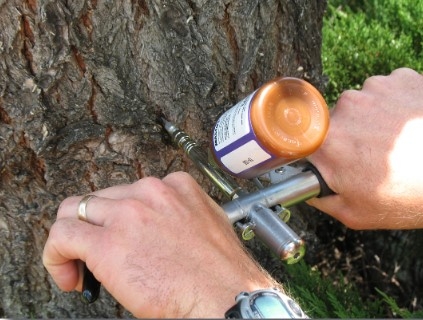
Posts Tagged: trunk
Tree Trunk Injection Review
Trunk injection is a technique for applying plant protection materials that offers an
alternative to foliar sprays or soil drenches. Among the main advantages that trunk injectionprovides over conventional methods are a higher efficiency of product delivery, reducedrisk for worker exposure, reduced risk to the environment, reduced harm to non-targetorganisms, and the possibility for use in populated areas where other methods are not anoption. Trunk injection techniques have not been optimized for use in commercialcrop production; however, there is a long history of using the method in a variety of cropand non-crop species.
According to the dictionary, the term “injection” is the act or process of forcing a
liquid medicine or drug into someone or something, usually by using a special needle. Inbotany, this term is used in a wider sense and includes any introduction of materials into aplant organ by cutting or through holes with or without force. In this sense, the earliestevidence for plant injection is from the 12th century, when Arabic horticulturists appliedperfumes, spices, dyes, and other substances through wounds in plants to affect the smell,color, or other attributes of flowers and fruits [3]. The first documented experimentationon trunk injections occurred in the 15th century by Leonardo da Vinci, who injectedarsenic and other poisonous solutions through bore holes into apple trees to render thefruit poisonous. Other experimentation until the early 1900s included injection of differentnutrient solutions such as ferrous sulphate and ferric chloride as remedies for nutritionaldeficiencies. This was followed by injection of other inorganic substances such as ironpyrophosphate, potassium cyanide, potassium phosphite and aluminum sulphate to control insects and plant
diseases. In addition to inorganic materials, organic substances including salicylic acidand plant- and microorganism-derived liquids were injected by various methods for thesame purpose.
A recently published literature review on trunk injection of citrus provides an excellent literature review and summary of pros/cons. "Trunk Injection as a Tool to Deliver Plant Protection Materials—An Overview of Basic Principles and Practical
Considerations" by Leigh Archer, Jonathan H. Crane, Ute Albrecht * has been
published in Horticulturae and is available online:
Abstract: https://www.mdpi.com/2311-7524/8/6/552
HTML Version: https://www.mdpi.com/2311-7524/8/6/552/htm
PDF Version: https://www.mdpi.com/2311-7524/8/6/552/pdf
https://forestry.usu.edu/files/utah-forest-facts/getting-chemicals-into-trees-without-spraying.pdf
Water. Water. Water. And We Still Need to Learn How to Use It Right.
A recent grower survey in Santa Barbara County asked a whole bunch of questions. One of which was had they had an evaluation of irrigation distribution uniformity. This is a free service that can significantly improve on-farm water use and most importantly improve plant health. Avocados that don't get the right amount of water at the right time are extremely susceptible to root rot. Proper irrigation is the first line of defense against root rot, good farming that results in good economic returns to the grower.
So, with a free DU available to growers, how many do you think took advantage of the service? Barely 50%!!!!!!!! This just does not make sense. In a land of little water and frequent examples of what can happen with no water ………………..and high priced water, what is going on?
The local Resource Conservation District has done many system evaluations, and most results find that improvements can be made in distribution uniformity. This is true in relatively new irrigation installations. It does not take long for problems to occur in even well designed and installed systems.
During the summer of 2007, the Casitas Municipal Water District (CMWD) contracted with the Irrigation Training and Research Center (ITRC) of California Polytechnic State University, San Luis Obispo, to conduct field evaluations of drip/micro systems. A team of two students conducted 35 field evaluations.
Distribution Uniformity (DU) – DU is a measure of the uniformity of water application to trees throughout an orchard, with DU = 1.0 being perfect. The measured orchard DUs in the Santa Barbara/Ventura area had an average DU of 0.66, while the California state average for drip/micro is 0.85.
In general, there were substantial opportunities to improve the distribution uniformity (DU) of the water to trees throughout an orchard. An improved DU will minimize over-irrigation in some areas, and reduce under-irrigation in others. Key recommendations that were provided included:
Install a pressure regulator at the head of every hose
With a regular microsprinkler, doubling the pressure causes about 40 percent more water to come out of the nozzle. Pressure regulators are added to have similar pressures throughout the orchard and thus reduce the risk of over-irrigating portions of the field. On many farms, the difference between the highest pressures was double or even triple the lowest pressures (40-70% more water). By adding the correct high-quality, pre-set pressure regulators with the correct flow rate rating, the farmer can get similar pressures to every nozzle and prevent over-irrigation.
For a pressure regulator (PR) to work, more pressure must enter the PR than what the PR is rated for. For example, to use a 25 psi PR, you need at least 27 psi into the PR. All a PR does is reduce pressure; it cannot add pressure.
Another problem on hillsides is that some pipes have as much as 100 psi before the PR. A PR can effectively reduce the pressure down to 50%. What is recommended in these fields is to reduce the pressure in the pipe by adding an in-line valve halfway down the hill and throttling it down to a reasonable pressure.
Completely replace all microsprinkers with pressure compensating microsprinklers
Pressure compensating microsprinklers have an internal flexible diaphragm that reduces a pathway as the pressure increases. These allow similar amounts of water to get the trees even if the hoses do not have the same pressures. Whenever the pressure is doubled, 10 percent more water will come out of these emitters, compared to 40 percent more water with a regular microsprinkler. Having pressure compensating emitters can drastically improve the DU in virtually every avocado orchard because most irrigation systems were not properly designed for microsprinkler systems, or because the farmer has altered the original design by adding different-sized nozzles.
Reduce plugging problems
Major plugging problems are found in all orchards that did not have good filtration, even those that get district water. There were also some “within-system” causes of plugging. Almost all plugging is from simple dirt or rust, as opposed to bacteria or algae. Recommendations are as follows:
- Always have a filter at the head of the system. The required mesh size depends on the microsprinkler flow rate, but 120 mesh is a starting point.
- Remove hose screen washers that are found at the head of hoses, and replace them with regular washers (after installing a filter at the head of the system). The hose screen washers often plug up and cause the hoses to have unequal inlet pressures.
- Be sure to thoroughly flush hoses after any hose breaks.
- Double check the type of fertilizer that is being injected, especially any “organic fertilizers”. Some of these can plug emitters. In any case, inject the fertilizers upstream of the filters. If the filter plugs up, it is better to have discovered the problem early.
- Clean the filters frequently. Install pressure gauges upstream and downstream. When the pressure differential (as compared to a clean screen) increases by 3-5 psi, it's time to clean the screen.
In some orchards, there is a big plugging problem caused by insects crawling into emitters after the water is shut off. Many of the new microsprinkler designs utilize a self-closing mechanism to prevent insects from coming into the nozzle.
We have gotten a reprieve with the rains and refilled reservoirs, but it is ever more important to make sure our irrigation systems are doing what they are supposed to be doing. Call your local Resource Conservation District and get information about a system evaluation. Contact numbers can be found at: http://www.carcd.org/rcd_directory0.aspx
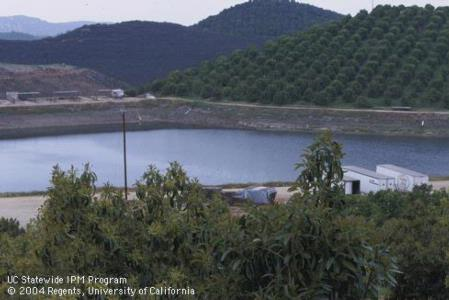
irrigation pond
Phire, Phlood, Phreeze and Fytophthora
A great idea from Ed McFadden of Philmore
You can always do something to prevent or correct the Big 4 that seem to strike avocados on a regular basis somewhere in California. Avocados in the back country are right up against areas that can burn easily. A fast fire can send embers into an orchard which can burn through the thick leaves in a slow burn. If it gets up against leaves piled up against the trunk, it can girdle the tree, killing it. The slow burn can continue through the orchard torching the irrigation lines. With a small fire break where the leaves are removed in a small alley, the burn can be slowed or stopped.
Leaves are great for erosion control, for nutrient cycling and disease control, but if they mean increasing potential for fire spread, it's a good idea to remove a little of it. Ed has found that a backpack blower can rapidly remove leaves from around the base of trees and create a narrow fire break that can reduce fire damage to trees.
Avocado orchards are notable for their ability to actually reduce fire hazard and slow major fires as has been shown in fires in San Diego, Ventura and Santa Barbara. This is partly due to running sprinklers during wild fire. But tree loss can still occur, especially when electricity goes down and pumps can't run.
Little rain this year or too much rain this year can always pose a hazard to avocado orchards. This sure seems like a good idea to me. And maybe it's time to start thinking about fire season now.
Photos: Cleared alley and trunk.
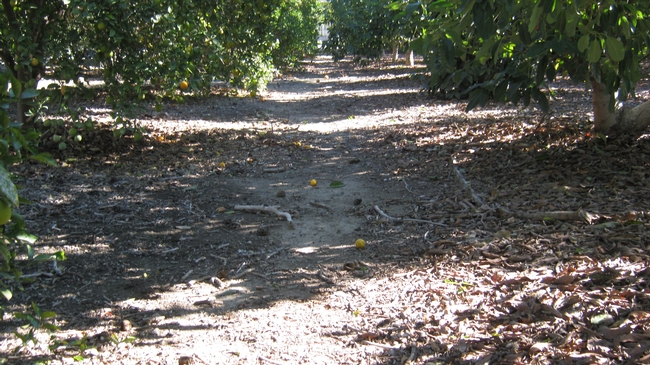
fire alley
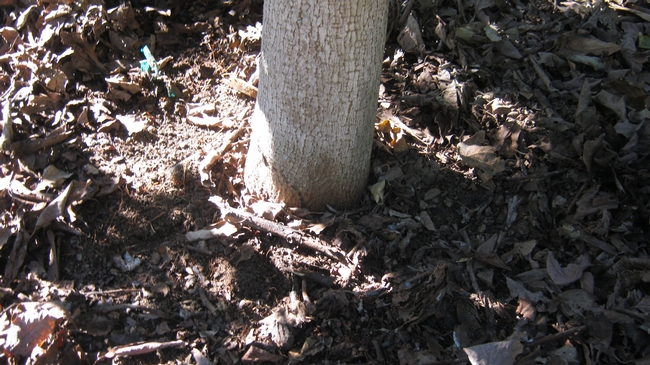
fire trunk
Assessing Fire Damage to Avocado
The destruction after a fire can be pretty gruesome and sad. Many times, though the fire moves through the orchard so fast that, even though the canopy has turned brown, there is a good chance the trees can come back. It all depends on how much damage has been done to the trunk. If the fire has substantially damaged the base of the trunk, it is unlikely to come back, even if the canopy is still green. That is the saddest thing, because you think you've dodged the bullet, but if the trunk is too damage, the canopy collapses gradually over a few weeks. However, the canopy may look a goner, but if the trunk is still intact, the tree will come back and may still be as productive as before.
The thing to look for at the base of the trunk is the discoloration. If it's black, it's probably not coming back. However, it can come back if after a few weeks you don't see the pencil-sized cankers that indicate that the sap has bubbled to the surface (see photo 1 below). If after a few weeks, the trunk is still clear of those bubbles (photo 2), even though the canopy looks gone, it is quite likely to come back.
It's also possible that the trunk may be damage in just one part of the trunk and not on the rest. In this case, it can also come back. The problem with these ones, is that they may come back and given enough time will be good trees again. But if they haven't recovered enough and there's a sudden heat spell, they may go down suddenly as if they had been burned again. That's the way they will look, like they have been burned again. Given enough time, though the avocado will grow from good areas to cover the poor areas and the tree may be productive again.
Avocados are amazing in their ability to recover. Eucalyptus can do it. But you singe the trunk of a lemon, and good-bye lemon.
Fire Information:
http://ceventura.ucanr.edu/Agricultural_Threats/Fire_Information/
Photo 1 and 2.
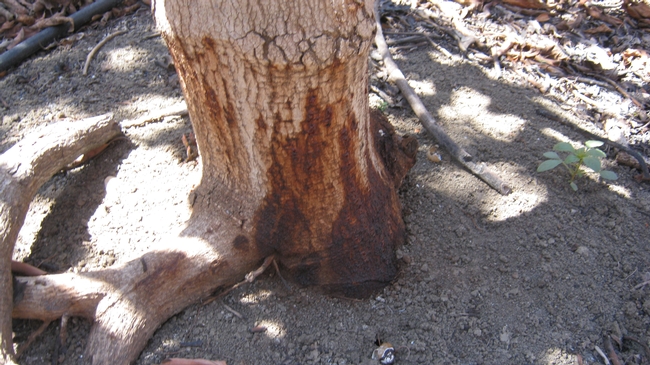
IMG 2040
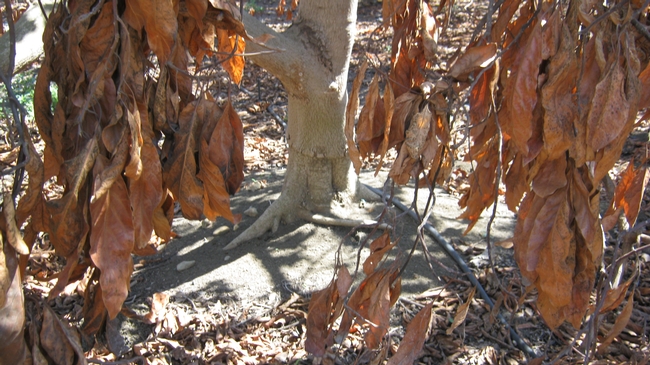
IMG 2041
And Here's the Rest of the Story - The Case of the Broken Trunks
So I got an email with an attached set of photos showing a number of 18 month avocado trees that had broken at the ground line in a wind storm. It looked something like an incompatibility between scion and rootstock, since below the graft union the rootstock girth was substantially smaller than the scion. The problem is, I'd never heard of this between ‘Hass' and ‘Dusa' and the combination has been around for at least 15 years in trials.
So it was time to go out to the orchard and see the setting in which the trees had failed. And there was the answer. All of the trees had been planted too deeply. The trunk sleeves had been buried and the graft union was below grade and had been infected by disease organisms. The crown roots are the most active physiologically and that union area is a weak spot. Burying it encourages disease and a weak union.
The trees had been planted with an auger and over time the trees had settled into the soft earth and had been buried. The first time I had ever seen something like this was in Guatemala and Costa Rica. There growers had created these massive 3 x 3 X 3 foot holes and amended them 50% with compost. And over time, the trees had settled as the compost decomposed and the unions were covered with dirt. Occasionally you see people moving too fast when they are planting and this shows up in a few trees, not usually a whole orchard.
The lesson here, is that if you are going to err on plant depth, plant high. A few exposed roots won't hurt, and the settling problem doesn't become a problem. Of course it's best to plant just right.
Broken Trunks
The Buried Avocado Graft Union

avocado root rot 4

buried trunk 6

